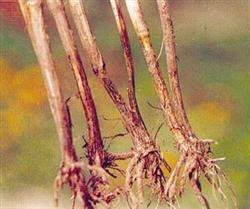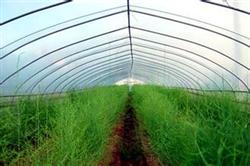Causes and control of a large number of dead plants of asparagus

The reasons for asparagus death are as follows: 1. Asparagus likes light. From September to October 2007, when the aboveground parts of asparagus grew vigorously and accumulated nutrients, which laid the foundation for the next year's high yield, suddenly encountered the continuous overcast and rainy weather not seen for many years, the light was seriously insufficient, resulting in the stagnation of asparagus growth, the decrease of nutrition accumulation and the decrease of stress resistance. 2. Asparagus is native to the east coast of the Mediterranean and Asia minor. It has a dry climate and little rain. In addition, the root system of asparagus is developed, the aboveground leaves are degraded, and the abnormal branches-- pseudo-leaves are small and needle-like, and their transpiration is very small, so they are very resistant to drought and extremely intolerant to waterlogging. A few days of stagnant water in the field will lead to root rot and death. Asparagus planting, continuous growth for many years, the land can not be ploughed, artificial harvest, often trampled, coupled with the application of a large number of chemical fertilizers, resulting in the destruction of soil structure, soil consolidation is very serious. In particular, the water permeability and air permeability of the soil under 20 cm is very poor. This not only affects the growth and development of roots, weakens the absorption performance, reduces the stress resistance of plants, but also after rain and watering, water can not seep into the ground, stagnant water on the surface for a long time, it is easy to cause root rot due to waterlogging. As the water cannot seep into the ground in large quantities, the water on the surface evaporates quickly and must be irrigated many times, which not only increases the labor of watering, but also increases the chance of waterlogging. In this case, the continuous overcast and rain from September to October 2007 is the main reason for a large number of dead asparagus plants. 3. Asparagus is harvested in spring and early summer, and people's management is fine. In autumn, the shoot grows vigorously and the management is negligent, coupled with the application of a large amount of nitrogen fertilizer, the aboveground density is larger, which affects ventilation and light transmission, which not only reduces the stress resistance of the plant, but also provides favorable conditions for the occurrence of diseases. 4. In the continuous overcast and rainy weather, the air humidity is very high, which makes the transpiration of leaves nearly stagnant, seriously reduces the water absorption of roots, and greatly reduces the nitrogen, phosphorus, potassium, zinc, boron, calcium and other trace elements brought to leaves by water. Therefore, the symptoms of deficiency such as yellowing, scorch and green loss of branches and leaves obviously occur, which reduces the stress resistance of plants and creates conditions for the occurrence of diseases. 5. In the humid air environment, diseases such as brown spot, rust, stem blight and Fusarium wilt occurred seriously. Because of frequent rain, the broad masses could not spray, which relaxed the prevention and control of the disease and aggravated the harm of the disease. Under the combined action of the above factors, asparagus dried up and yellowed in a large area, and finally the whole plant died. The measures to prevent asparagus death are as follows: 1. Combine watering in early spring and apply soil conditioner-no deep tillage, 200-400 grams per mu, to make the soil 30-50 cm deep loose and transparent. This is not only conducive to the growth and development of the root system, strengthen the absorption capacity, but also improve the water storage capacity of the soil, the water quickly seeps to the lower layer of the soil after rain or watering, and there is no water on the ground surface to reduce the occurrence of waterlogging; in the case of drought, there is water storage in the lower layer of the soil. Drought damage will not occur, reduce the number of watering, and avoid the disadvantages caused by watering in continuous rainy days. 2. On continuous rainy days, the root system can not normally absorb potassium, calcium, magnesium, iron, zinc and other metal elements, so the measure of soil topdressing should not be used, but the above fertilizer elements should be applied outside the root every 5-10 days, and the concentration is about 0.3%. The problem of lack of fertilizer elements can be solved by foliar fertilization. 3. Natural brassin Shuofeng 481, a plant growth regulator, should be sprayed every 10-20 days in overcast and rainy days to promote photosynthesis, improve the nutritional production of asparagus and improve stress resistance. 4. Topdressing in summer should be combined with nitrogen, phosphorus and potassium, not partial application of nitrogen fertilizer to avoid overgrowth. For overgrowing plants, some weak and diseased branches should be properly cut off to improve ventilation and light transmission conditions and reduce field humidity. 5. pay attention to timely drainage in the rainy season to avoid waterlogging. 6. Spray medicine in time on cloudy and rainy days to prevent the occurrence of diseases. Phosphorus and potassium fertilizer should be properly applied to asparagus rust, stem blight, brown spot, blight (Fusarium wilt), crown rot, anthracnose, stem rot, root rot and other diseases; cut along the soil surface during harvest, bury or burn the withered and diseased bodies deeply, and pay attention to remove weeds; drain water in time after rain to reduce soil moisture. The initial use of 20.67% Wanxing EC 2000-3000 times, or 72% Kelou wettable powder 600x, or 68.75% DuPont easy to retain water dispersible granules 800-1000 times, or DuPont Yikuanjing 2000 times Or 50% promethazim wettable powder 1500 times liquid, or 50% carbendazim wettable powder 1000 times liquid, or 70% thiophanate methyl wettable powder 1000 times liquid, or 40% polysulfide suspension or 50% mixed sulfur suspension 500x liquid, or 64% poison alum wettable powder 500x liquid, or 2%BO-10 water agent 1000 times liquid, spray every 10 days or so, continuous prevention and control 3-4 times.
- Prev

Anti-season cultivation techniques of asparagus in greenhouse
The hybrid varieties with strong disease resistance and fast growth were selected, such as 2000-3 and Champion. The main way of sowing and raising seedlings is from February to April. Soak the seeds with 50% carbendazim wettable powder for 12 hours, then soak them in 30-35 ℃ warm water for 2-3 days, remove the seeds, cover them with wet towels and rinse the seeds with warm water every day.
- Next

Key points of raising seedlings of asparagus in spring
Asparagus production generally adopts seedling transplanting, and the seedling emergence rate of centralized seedling transplanting is high, which can save seeds, reduce costs, facilitate centralized management, help to control diseases and insect pests and cultivate strong seedlings, prolong the growth period of the planting year and increase the yield of the second year. Seedlings can be oriented according to the growth direction of asparagus.
Related
- Where is it suitable to grow horseradish in China? it is expected to see the middle altitude horseradish in Alishan.
- How to prevent tomato virus disease reasonably? (Control methods included)
- Many people like to plant towel gourd on the balcony. What are the main points of this method and management?
- What crops can chili peppers be mixed with?
- Fertilization techniques and matters needing attention in Tomato
- What are the grafting techniques for peach seedlings in spring?
- Harm and control methods of root swelling disease of Chinese cabbage
- What are the pests of sweet potatoes? How to prevent and cure it?
- Symptoms, causes and Control methods of navel Rot in Tomato
- The cause of "Cucumber rotten bibcock" in Farmers' planting Cucumber and its Control Plan

